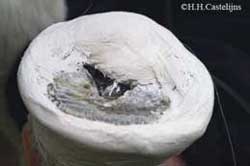
The acute laminitic patient: Biomechanical treatment options. |
||||
Introduction:Laminitis is a medical emergency, but also requires urgent mechanical measures, aimed at diminishing tension on the inflamed laminae, pressure on the anterior sole under the distal margin of the coffin bone and finally the asymmetrical tensions on the hoof capsule produced when the horse turns. These mechanical measures can be obtained in many ways: Duct taping polystyrene foam pads under the hoof/hooves. The advantages of this last procedure can be summarized as follows: quick, cheap, clean, easy to apply, to change, and to mould to the required shape. Materials and methods:With a bucket of water (warm, to speed up the process) and 3-4 rolls of plaster (CaSO4 x 2H2O), 10 cm wide for small/medium feet, 15 cm high for large feet, one proceeds to unroll the first drenched roll in one's hands, after squeezing out the excess water, molding it into a rounded mass to be applied to the caudal part of the foot. With the other 2-3 (wetted) rolls one wraps the hoof, holding the initial “ball” in place and leaving the sole, anterior to the frog, free. The hoof should be preferably unshod and trimmed moderately, especially the toe should be trimmed if to long. The “ball” of plaster should protrude from under the distal margin of the hoof at the heels. The wrapping should be performed in the usual, diagonally alternated way: medial bulb-lateral toe, lateral bulb-medial toe. Care should be taken to round off the proximal part of the cast, around the coronary band and the bulbs, before the plaster sets, so as to avoid pressure sores (do not use synthetic casting material). The final result should distantiate the sensitive anterior sole from the ground and transfer weight to the caudal part of the sole, bars and frog. Using fresh plaster bandages and warm water, an efficient helper holding up the leg and having placed the contra-lateral limb on a soft padding material, the quick setting time of plaster usually permits the application of the cast without regional anesthesia to the weight bearing limb. Always start with the most painful foot first. Results: Weight is transferred in a stable manner to the frog, bars and palmar/plantar sole, unloading the dorsal wall and laminae; the dorsal sole is raised away from the ground and lateral medial break-over is enhanced making turning less painful. On removing the plaster cast (with a cast cutter, or a toeing knife) the under laying structures, including the frog grooves, have a clean aspect without excessive build up of humidity. This is a common method used in some European countries (e.g. Germany) 1 and has been used for over 10 years by the author as an emergency care measure, with an average of 28 patients a year. Discussion:With a bit of practice the procedure is quite easy and effective in the acute stage of laminitis, as it diminishes laminar tension in the dorsal part of the hoof thanks to the raised heels (diminished deep digital flexor tendon pull) and stabilizes the hoof capsule relative to its laminar suspension apparatus. The malleability of plaster is useful in customizing the emergency support system, e.g. higher or lower heel support more lateral or medial etc. as needed and seems more stable than some of the other emergency mechanical methods. It is important to use plaster cast, and not synthetic casting material, the later being much lighter, stronger, but also sharper at the edges. As the horses do not always stand perfectly still, due to the discomfort on the weight bearing limb, it is hard to keep the proximal edge of the cast below the coronary band, while wrapping the cast invariably goes over the bulbs. With plaster casts the author hasn’t encountered any skin, bulb or coronary band ulcerations, which are an easy complication with the use of synthetic casts. On the other hand, if the horse is doing well and moving about, it can be useful to cover the dorsal sole with a rigid pad (there should remain space between the pad and the sole), fixed to the lower part of the original plaster cast with a synthetic one, as this renders the arrangement a lot more wear resistant. A plaster cast of the hoof, thus applied, should be seen as a mechanical emergency measure, to be used till the acute phase has stabilized (one to three weeks), after which a more durable shoeing solution should be found. References:1. Huskamp, B. Orthopedic measures with laminitis of the horse. Proceedings MICEM 2004; 132-137 |
|
|||


